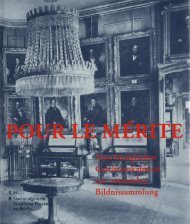- Seite 3:
ORDEN POUR LE MÉRITE FÜR WISSENSC
- Seite 6 und 7:
Zweiter Teil Die Jahrestagung des O
- Seite 8 und 9:
3. Aufnahme neuer Mitglieder: Lauda
- Seite 11:
erster Teil herbsttagung DES ORDENS
- Seite 14 und 15:
daß die kommunistische Partei, die
- Seite 16 und 17:
den Brief ihrer polnischen Mitbrüd
- Seite 18 und 19:
maligen Chef der polnischen Diploma
- Seite 20 und 21:
einst schrieb, »Fatalismus der Fei
- Seite 22 und 23:
die Erweiterung nicht gutheißen we
- Seite 24 und 25:
ika verdankt, könnten in dieser Hi
- Seite 26 und 27:
gegen die Vereinigung des städtisc
- Seite 28 und 29:
An der Grenze zu Polen gelegen, pr
- Seite 30 und 31:
tieren. Es muß der freie Wille der
- Seite 32 und 33:
das Europadiplom des Europäischen
- Seite 34 und 35:
Am 5. Mai 1998 wurde in der gemeins
- Seite 36 und 37:
aufgebaut, dient sie nicht nur als
- Seite 38 und 39:
eine erfreuliche Bestätigung für
- Seite 40 und 41:
ehemals deutscher Territorien, die
- Seite 42 und 43:
tigkeit begann. Erst seit diesem Ze
- Seite 44 und 45:
Aber nicht nur in unserer Namensgeb
- Seite 47 und 48:
HORST FUHRMANN SCHLESIEN - ŚLĄSK
- Seite 49 und 50:
II Das Ziel jedoch war Kreuzburg bz
- Seite 51 und 52:
sche Überlegungen zur Funktion der
- Seite 53 und 54:
mehr, niestety (leider).« Melancho
- Seite 55 und 56:
erinnerte, es ist das reine Landst
- Seite 57 und 58:
Es ist eine Lust, in den fast drei
- Seite 59 und 60:
ERWIN NEHER SIGNALMECHANISMEN DES N
- Seite 61 und 62:
ziten in diesen Eigenschaften bei K
- Seite 63 und 64:
des Muskels auslöst, und auf die W
- Seite 65 und 66:
en wurde eine Vielzahl von Proteine
- Seite 67 und 68:
Die Nervenfasern, welche vom Geniku
- Seite 69 und 70:
Die Neurowissenschaften: “Top-Dow
- Seite 71 und 72:
Synaptische Übertragung Ein Nerven
- Seite 73: Auf dem Weg von den Lichtrezeptoren
- Seite 77: erstes kapitel bericht über die in
- Seite 80 und 81: zw. befinden, in der an den deutsch
- Seite 83: 1. reden beim mittagessen auf einla
- Seite 86 und 87: nur ein hundertfach beschnittenes,
- Seite 88 und 89: 1908: Rat der Stadt Dresden kauft d
- Seite 90 und 91: sitzung in Vilnius das Welterbe Dre
- Seite 92 und 93: daß die Mehrheit der Dresdnerinnen
- Seite 94 und 95: egionale Entscheidung handelt und e
- Seite 96 und 97: aktuellen Streit um die »Waldschl
- Seite 99: 2. vervielfältigung und selektion:
- Seite 102 und 103: solange die Bedingungen zur Verviel
- Seite 105 und 106: Manfred Eigen Über den Begriff der
- Seite 107 und 108: hung? Welche Mechanismen werden hie
- Seite 109 und 110: tion innerhalb der ca. 10 16 Sekund
- Seite 111 und 112: Was ist nun ein »Hyperzyklus«? Ic
- Seite 113 und 114: Sie ist durch die hier diskutierten
- Seite 115 und 116: Robert Weinberg the evolutionary or
- Seite 117 und 118: ample from the United States, where
- Seite 119 und 120: through, we imagine, 10 20 cell div
- Seite 121 und 122: cer; this probably represents the m
- Seite 123: genes, each of these red segments,
- Seite 127 und 128: V. Leaving Darwin, I want to give y
- Seite 129 und 130: have left the outer layer, rounded
- Seite 131 und 132: Figure 3: The Biology of Cancer (©
- Seite 133 und 134: Figure 7: The Biology of Cancer (©
- Seite 135 und 136: Figure 11: The Biology of Cancer (
- Seite 137 und 138: Figure 15: The Biology of Cancer (
- Seite 139 und 140: Figure 19: The Biology of Cancer (
- Seite 141 und 142: Figure 23: The Biology of Cancer (
- Seite 143 und 144: Figure 27: The Biology of Cancer (
- Seite 145 und 146: Figure 31: The Biology of Cancer (
- Seite 147 und 148: Figure 35: The Biology of Cancer (
- Seite 149 und 150: Figure 39: The Biology of Cancer (
- Seite 151 und 152: Figure 43: The Biology of Cancer (
- Seite 153 und 154: Figure 47: The Biology of Cancer (
- Seite 155: 3. musikwissenschaften
- Seite 158 und 159: Markenartikel gemacht. Der Vorsitze
- Seite 160 und 161: derts notabene, von dem Mozart und
- Seite 162 und 163: kums entgegenkommen und die zugleic
- Seite 164 und 165: Worten Assmanns: »Märchen und Mys
- Seite 167 und 168: Ludwig Finscher zum gedenken an Gy
- Seite 169 und 170: Werkes nachdrücklich wiederhergest
- Seite 171: zweier großer Komponisten, über d
- Seite 174 und 175:
lichkeiten des Horns mit seinem unv
- Seite 177:
4. philosophie
- Seite 181 und 182:
Caritas fide formata Die erste Enzy
- Seite 183 und 184:
edende ecclesia docens als eine Kir
- Seite 185 und 186:
christlichen Glauben und der nach a
- Seite 187 und 188:
summo meo), mir näher kommt, als i
- Seite 189 und 190:
nur dann kritisch beurteilt, wenn e
- Seite 191 und 192:
des schwedischen Lutheraners Anders
- Seite 193 und 194:
Die Luther-Interpretation des Luthe
- Seite 195 und 196:
tierten »unheimlichen Spruch«: »
- Seite 197 und 198:
Auch nach Luther weiß sich also de
- Seite 199 und 200:
aber - im Unterschied zum darzustel
- Seite 201 und 202:
großer Dringlichkeit - Aids! - ste
- Seite 203 und 204:
hat eine genuin biblische Frage ges
- Seite 205 und 206:
15 Ebd., a.a.O. 10. 16 Nr. 4, a.a.O
- Seite 207 und 208:
64 Nr. 14, a.a.O. 22. 65 Vgl. M. Lu
- Seite 209:
zweites kapitel bericht über die
- Seite 213 und 214:
Horst Albach, Kanzler des Ordens Ho
- Seite 215 und 216:
präsidenten in Berlin gibt ein ein
- Seite 217:
Im vergangenen Jahr hat Hans Magnus
- Seite 221:
elisabeth legge-schwarzkopf 9. Deze
- Seite 226 und 227:
Society und seit den zwanziger Jahr
- Seite 231 und 232:
Gedenkworte für Carl Friedrich von
- Seite 233 und 234:
ig scharf messen kann, sondern dies
- Seite 235:
paul b. baltes 18. Juni 1939 - 7. N
- Seite 240 und 241:
Jugendalters befaßt und den Einflu
- Seite 242 und 243:
figeres Studium dieser wenigen Werk
- Seite 244 und 245:
ihrem Tod seine wissenschaftliche M
- Seite 247:
györgy ligeti 28. mai 1923 - 12. j
- Seite 252 und 253:
Kunst der Sprachpolyphonie. Wer das
- Seite 254 und 255:
a) Sein frühkindlicher Urtraum: re
- Seite 257:
aufnahme neuer mitglieder: laudatio
- Seite 260 und 261:
Nun stellen Sie sich einen Gerichts
- Seite 262 und 263:
Jahren sich häufiger solidarisch v
- Seite 264 und 265:
dies Werk über die Begründung mod
- Seite 266 und 267:
meiner Geschichte, das heißt mit d
- Seite 268 und 269:
Stellung der EU und anderer regiona
- Seite 270 und 271:
liche Vorabentscheidung nach den Ve
- Seite 273:
4. tischreden beim abendessen im sc
- Seite 276 und 277:
sage wird wahrscheinlich jeder gern
- Seite 278 und 279:
Für dieses Sichtbar-Machen von Wah
- Seite 280 und 281:
fügen: Wir haben Glück, wenn wir
- Seite 282 und 283:
en, man könne bei Bildungsinvestit
- Seite 284 und 285:
Diskussion vornehmlich mit den äu
- Seite 286 und 287:
strativen Apparat zu bedienen. Seku
- Seite 289 und 290:
Bericht Über das Ordensjahr 2006/2
- Seite 291 und 292:
glieder zu einem Mittagessen ein. S
- Seite 293 und 294:
Bericht Über das Treffen mit Berli
- Seite 295 und 296:
Bericht Über das Treffen im August
- Seite 297 und 298:
Sehr geehrter Herr Kanzler, ich mö
- Seite 299:
ildteil
- Seite 302 und 303:
Herbsttagung in Görlitz Eintrag in
- Seite 304 und 305:
Sitzung der Ordensmitglieder in Ber
- Seite 306 und 307:
Sitzung der Ordensmitglieder in Ber
- Seite 308 und 309:
Sitzung der Ordensmitglieder in Ber
- Seite 310 und 311:
Sitzung der Ordensmitglieder in Ber
- Seite 312 und 313:
Sitzung der Ordensmitglieder in Ber
- Seite 314 und 315:
Reinhard Selten 314
- Seite 316 und 317:
Christian Tomuschat 316
- Seite 318 und 319:
Öffentliche Sitzung im Konzerthaus
- Seite 320 und 321:
Öffentliche Sitzung im Konzerthaus
- Seite 322 und 323:
Öffentliche Sitzung im Konzerthaus
- Seite 324 und 325:
Öffentliche Sitzung im Konzerthaus
- Seite 326 und 327:
Öffentliche Sitzung im Konzerthaus
- Seite 328 und 329:
Die Schülergruppe des Augustum-Ann
- Seite 330 und 331:
Besuch des Deutschen Historischen M
- Seite 332 und 333:
Besuch des Deutschen Historischen M
- Seite 334 und 335:
Besuch des Deutschen Historischen M
- Seite 337:
anhang
- Seite 340 und 341:
1969 eine Ergänzung der Satzung du
- Seite 342 und 343:
(2) Scheidet der Kanzler oder ein V
- Seite 344 und 345:
(2) Es können insofern neue Mitgli
- Seite 347:
VERZEICHNIS DER DERZEITIGEN MITGLIE
- Seite 350 und 351:
A D (I) KÖ AP U E (A) M, I S M E
- Seite 352:
Sekretariat des Ordens Pour le mér














